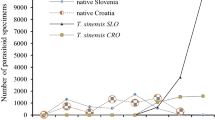Abstract
The seasonal cycle and population dynamics of Schizotetranychus nanjingensis Ma and Yuan, Aponychus corpuzae Rimando (Tetranychidae), Aculus bambusae Kuang (Eriophyidae) and their natural enemy Typhlodromus bambusae Ehara (Phytoseiidae) were studied during 1996–1998 in moso bamboo forests in Nanping, Fujian, China. Damage to bamboo leaves was often caused by mixed populations of the three phytophagous species, which displayed different seasonal dynamics: S. nanjingensis fed actively and reproduced in May and from late July to late October (aestivating from June to mid July), Ap. corpuzae was active and reproduced from mid July to late November, and Ac. bambusae from July to next February. During Spring S. nanjingensis was the dominant species with the greatest niche width, but in Summer Ac. bambusae and Ap. corpuzae became dominant and had greater niche widths. In Autumn, Ac. bambusae decreased but both S. nanjingensis and Ap. corpuzae mites increased and the latter became dominant. In winter all species decreased sharply in number. The two spider mite species (S. nanjingensis and Ap. corpuzae) had high niche overlaps in all four seasons. Niche overlaps between the eriophyid Ac. bambusae and the two spider mites were similarly high except during the spring when Ac. bambusae was absent. The predatory mite (T. bambusae) had higher niche overlap with Ap. corpuzae than with others during Autumn and Winter, but during Spring and Summer niche overlap was higher with S. nanjingensis.
Similar content being viewed by others
References
Levins, R. 1968. Evolution in Changing Environment. Princeton University Press.
Lin, J.,Zhang, Z.-Q.,Zhang, Y.,Liu, Q. andJi, J. 2000. Checklist of mites from moso bamboo in Fujian, China. Syst. Appl. Acarol. (Spec. Publ.) 5: 81–92.
Liu, H.,Zhao, Z.,Wang, J.,Li, L.S. andDing, W. 2000. Temperature-dependent development and reproduction of the spider mite, Schizotetranychus bambusae Reck (Acari: Tetranychidae). Syst. Appl. Acarol. 5: 33–39.
Pianka, E.R. 1973. The structure of lizard communities. Ann. Rev. Ecol. Syst. 4: 53–74.
Pratt, P.D. andCroft, B. A. 2000. Expanded distribution of the bamboo spider mite Schizotetranychus longus (Acari: Tetranychidae) and predation by Neoseiulus fallacis (Acari: Phytoseiidae). Acarologia 40: 191–197.
Saito, Y. 1979. Life history studies on Schizotetranychus celarius (Banks) and Aponychus corpusae Rimando as compared with other tetranychid mite species (Acarina: Tetranychidae). Appl. Entomol. Zool. 14: 445–452.
Saito, Y. 1990. Life history and feeding habit of Typhlodromus bambusae, a specific predator of Schizotetranychus celarius (Acari: Phytoseiidae: Tetranychidae). Exp. Appl. Acarol. 10: 45–51.
Sun, X.-Y.,Zhou, C.-G.,Liu, Y.-M.,You, C.-X. andYu, B. 1997. Preliminary studies on the biology ofSchizotetranychus bambusae. Scientia Silvae Sinicae 33: 274–277 (in Chinese).
Yu, H.-X. andShi, J.-M. 1991. Studies on Schizotetranychus nanjingensis. J. Bamboo Res., 10(2): 61–67 (in Chinese with English abstract).
Zhang, Y.-X.,Liu, Q.-Y.,Lin, J.-Z.,Song, M.-G. andHe, X.-Y. 1998a. Influence on the physiology and biochemistry of bamboo damage by the Schizotetranychus nanjingensis Ma et Yuan. Entomol. J. East China 7: 65–70 (in Chinese with English abstract).
Zhang, Y.-X.,Liu, Q.-Y.,Lin, J.-Z.,Song, M.-G.,Cai, Q.-J. andHe, X.-Y. 1998b. Studies on species distribution and damage by spider mites in bamboo trees in Fujian Province. J. Fujian Acad. Agric. Sci. 12(3): 11–15 (in Chinese with English abstract).
Zhang, Y.-X.,Zhang Z.-Q.,Lin, J.-Z. andLiu, Q.-Y. 1998c. Predation of Amblyseius longispinosus (Acari: Phytoseiidae) on Aponychus corpuzae (Acari: Tetranychidae). Syst. Appl. Acarol. 3: 53–58.
Zhang, Y.-X.,Zhang, Z.-Q.,JI, J. andLin, J.-Z. 1999a. Predation of Amblyseius longispinosus (Acari: Phytoseiidae) on Schizotetranychus nanjingensis (Acari: Tetranychidae), a spider mite injurious to bamboo in Fujian, China. Syst. Appl. Acarol. 4: 63–68.
Zhang, Y.-X.,Zhang, Z.-Q.,Liu, Q.-Y. andLin, J.-Z. 1999b. Biology of Schizotetranychus nanjingensis (Acari: Tetranychidae) with reference to effects of temperature on and importance of nests to its survival and development. Syst. Appl. Acarol. 4: 75–82.
Zhang, Y.-X.,Zhang, Z.-Q.Liu, Q.-Y. andLin, J.-Z. 1999c. Biology of Typhlodromus bambusae (Acari: Phytoseiidae), a predator of Schizotetranychus nanjingensis (Acari: Tetranychidae) on bamboos in Fujian, China. Syst. Appl. Acarol. 4: 57–62.
Zhang, Y.-X.,Zhang, Z.-Q.,Lin, J.-Z. andJi, J. 2000. Potential of Amblyseius cucumeris (Acari: Phytoseiidae) as a biocontrol agent against Schizotetranychus nanjingensis (Acari: Tetranychidae) in Fujian, China. Syst. Appl. Acarol. (Spec. Publ.) 4: 109–124.
Author information
Authors and Affiliations
Rights and permissions
About this article
Cite this article
Zhang, YX., Zhang, ZQ., Zhang, XJ. et al. Population dynamics of phytophagous and predatory mites (Acari: Tetranychidae, Eriophyidae, Phytoseiidae) on bamboo plants in Fujian, China. Exp Appl Acarol 25, 383–391 (2001). https://doi.org/10.1023/A:1017998024833
Issue Date:
DOI: https://doi.org/10.1023/A:1017998024833




